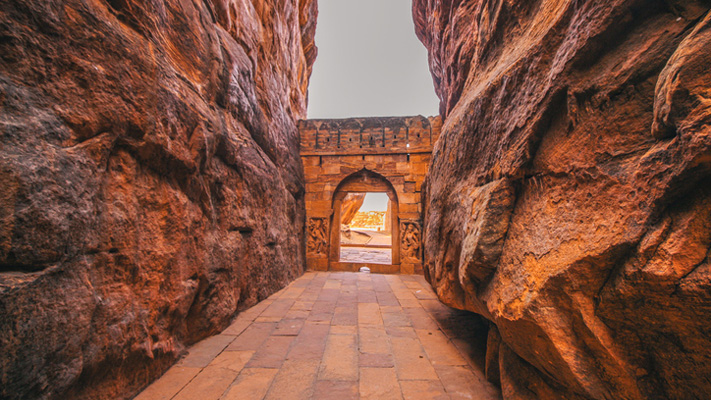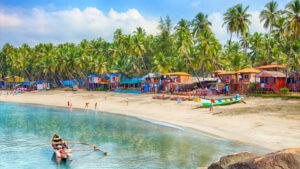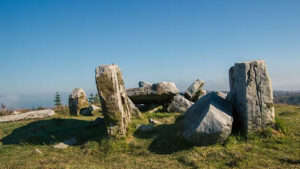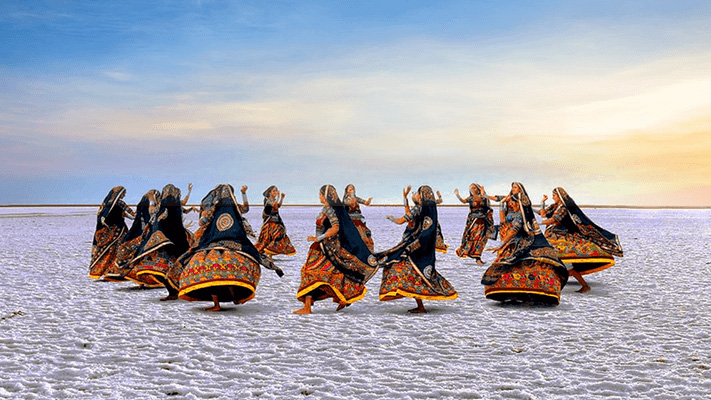BADAMI CAVES, KARNATAKA – EXPLORE THESE ENCHANTING CAVES WHERE ANCIENT WONDERS AWAIT

In the scenic town of Badami in Karnataka, India, the Badami Caves stand as a testament to the rich architectural and cultural heritage of the region. These awe-inspiring rock-cut cave temples draw travelers from near and far, offering a glimpse into a bygone era of artistic brilliance and religious devotion. Carved into the imposing red sandstone cliffs, the Badami Caves showcase a harmonious blend of Hindu and Jain artistry, with intricate sculptures adorning the cave interiors. As you explore this UNESCO World Heritage Site, you’ll be captivated by the grandeur of the cave temples, the mesmerizing rock formations, and the serene surroundings. Whether you are a history enthusiast, an art lover, or a spiritual seeker, a visit to the Badami Caves promises an unforgettable journey back in time, revealing the rich tapestry of India’s ancient past and the ingenuity of its craftsmen.

The Badami Caves hold great historical and architectural significance. Here is an overview of the Caves:
- Rock-Cut Architecture: The Badami Caves showcase impressive rock-cut architecture, dating back to the 6th and 7th centuries. The caves are carved into the rugged sandstone cliffs of a red sandstone hill, creating a dramatic and awe-inspiring sight.
- Four Cave Temples: There are four main cave temples in Badami, each dedicated to a different deity. Cave 1 is dedicated to Lord Shiva, Cave 2 to Lord Vishnu, Cave 3 to Lord Mahavira (Jain Tirthankara), and Cave 4 is a small temple dedicated to Lord Shiva.
- Intricate Sculptures: The cave interiors are adorned with intricate sculptures depicting various mythological scenes, deities, and divine beings. These sculptures exhibit exquisite craftsmanship and offer insights into the artistic traditions and beliefs of the time.
- Bhoothanatha Temple: Located near the Badami Caves, the Bhoothanatha Temple is an ancient Hindu temple dedicated to Lord Shiva. It is known for its architectural beauty and the intricate carvings on its walls.
- Badami Fort: Situated atop the hill overlooking the caves, the Badami Fort offers panoramic views of the surrounding landscape. It is a historical site that played a significant role in the region’s history.
- Nearby Attractions: Badami is also close to other tourist attractions, including the Aihole and Pattadakal temple complexes, which are UNESCO World Heritage Sites. These sites are known for their architectural marvels and historical importance.
The remarkable rock-cut architecture and intricate sculptures make it a must-visit destination for history enthusiasts, architecture lovers, and anyone seeking a deeper understanding of India’s cultural heritage.
Inside the caves
Stepping inside the Badami Caves is like entering a hidden world of artistic marvels and religious sanctity. As you venture into the cool, dimly lit interiors, you’ll find yourself surrounded by intricate rock-cut sculptures and beautifully carved pillars that transport you back in time.

Cave 1, also known as Ravanaphadi, is the largest and most impressive cave. Inside, you’ll be greeted by the towering figure of Lord Shiva as Nataraja, his cosmic dance frozen in stone. The walls of the cave are adorned with exquisite sculptures depicting scenes from Hindu mythology, including episodes from the Ramayana and Mahabharata.
Moving on to Cave 2, dedicated to Lord Vishnu, you’ll discover a treasure trove of sculptures depicting various forms of the deity, along with scenes from ancient Hindu epics. The intricate carvings and delicate details showcase the exceptional craftsmanship of the artisans who created them.
Cave 3, the Jain temple, exudes a serene and peaceful ambiance. The cave is adorned with sculptures of Jain Tirthankaras and other divine figures. The simplicity of the cave’s design allows visitors to appreciate the intricate details of the sculptures, which reflect the devotion and artistic finesse of the Jain community.
Lastly, Cave 4 stands as a small yet significant temple dedicated to Lord Shiva. The cave features elaborate carvings of Lord Shiva and the graceful figures of river goddesses, their forms delicately chiseled into the sandstone walls.
Inside each cave, shafts of natural light create a mystical atmosphere, illuminating the sculptures and enhancing their beauty. The play of light and shadows adds to the enchanting allure of the caves, making it a captivating experience for visitors.
Top Attractions Nearby
In addition to the captivating Badami Caves, there are several other attractions in the vicinity that are worth exploring. Here are some of the top attractions near Badami:
- Aihole: Located just 15 kilometers from Badami, Aihole is an ancient temple complex known as the “Cradle of Indian Architecture.” It houses over 125 temples, each displaying unique architectural styles and intricate carvings. The Durga Temple, Lad Khan Temple, and Ravana Phadi Cave Temple are some of the notable highlights.
- Pattadakal: Situated around 22 kilometers from Badami, Pattadakal is another UNESCO World Heritage Site renowned for its exquisite temple architecture. The site showcases a blend of Hindu and Jain temples, with the Virupaksha Temple being the most prominent. The intricate carvings and sculptures depict scenes from mythology and daily life.
- Banashankari Temple: Located approximately 25 kilometers from Badami, the Banashankari Temple is dedicated to Goddess Banashankari, an incarnation of Goddess Parvati. The temple is known for its unique Dravidian-style architecture and hosts a grand fair during the Banashankari Amma Devi Jatra festival.
- Mahakuta Group of Temples: Situated about 14 kilometers from Badami, the Mahakuta Group of Temples is a collection of ancient temples dedicated to Lord Shiva. The temples are surrounded by a serene water tank and lush greenery, creating a tranquil atmosphere. The annual Mahakuta Festival attracts devotees and cultural enthusiasts.

- Badami Fort: Perched atop a hill overlooking Badami, the Badami Fort offers panoramic views of the surrounding landscape. The fort dates back to the 6th century and showcases the architectural styles of different dynasties that ruled the region. It also houses several temples and structures of historical significance.
- Bhutanatha Group of Temples: Situated near the Agastya Lake, the Bhutanatha Group of Temples is a collection of beautifully carved temples dedicated to Lord Shiva. The temples, with their exquisite architectural details and serene surroundings, offer a peaceful atmosphere for meditation and contemplation.
Shopping and Dining
When it comes to shopping and dining in Badami, you can immerse yourself in the local culture and indulge in delightful experiences. While Badami is primarily known for its historical and architectural treasures, there are still opportunities to explore the local markets and savor delicious cuisine. Here’s a glimpse into the shopping and dining scene in Badami:
Shopping:
- Local Handicrafts: Explore the local markets to discover traditional handicrafts, such as intricately designed terracotta items, stone carvings, and brassware. These make for unique souvenirs and mementos.
- Fabrics and Textiles: Get a taste of the local fashion by browsing through shops offering vibrant traditional textiles like sarees, stoles, and dress materials. You can find a range of handloom and embroidered fabrics reflecting the cultural heritage of the region.
- Local Spices and Condiments: Don’t miss the opportunity to buy aromatic spices and condiments, such as turmeric, chili powder, cardamom, and tamarind. These flavorsome ingredients can add a touch of Badami to your culinary creations.
Dining:
- Local Cuisine: Indulge in the flavors of Karnataka by trying the regional cuisine. Don’t miss the chance to savor authentic dishes like Bisi Bele Bath (a flavorful rice and lentil dish), Jolada Rotti (sorghum bread), Mysore Pak (a sweet delicacy), and various dosas and chutneys.
- Local Restaurants and Street Food: Explore the local restaurants and eateries that offer a range of Indian and regional dishes. From small local joints to more upscale establishments, you can find a variety of options to suit your taste buds. Additionally, don’t forget to sample street food delights like pani puri, vada pav, and masala dosa.
- Local Sweet Shops: Treat yourself to a wide array of traditional sweets and desserts available at local sweet shops. From jaggery-based treats to milk-based sweets, you’ll find a delightful range of confections to satisfy your sweet tooth.
While the shopping and dining scene in Badami may not be as extensive as in larger cities, it offers an authentic and enriching experience.
Best Time to Visit
The best time to visit Badami is during the winter months, from October to February. During this period, the weather is pleasant with cooler temperatures, making it ideal for exploring the historical sites and outdoor activities in the area.
The summer season, from March to May, experiences high temperatures, making it less comfortable for outdoor activities.

How to Reach
By Air: The nearest airport to Badami is Hubli Airport, located approximately 100 kilometers away. From the airport, you can hire a taxi or take a bus to reach Badami.
By Train: The closest railway station to Badami is Badami Railway Station, located within the town itself. However, it is a small station with limited connectivity. The better option is to travel to Hubli Junction Railway Station, which is well-connected to major cities across India.
By Road: Badami is connected to various cities in Karnataka through a network of well-maintained roads. Regular bus services are operated from major cities like Bangalore, Hubli, and Belgaum to Badami. Private buses and taxis are also available for hire.

















































